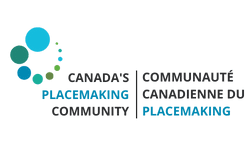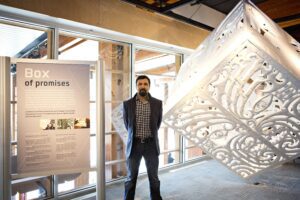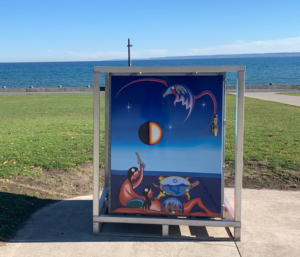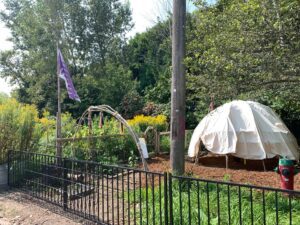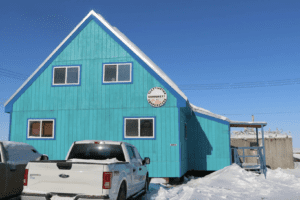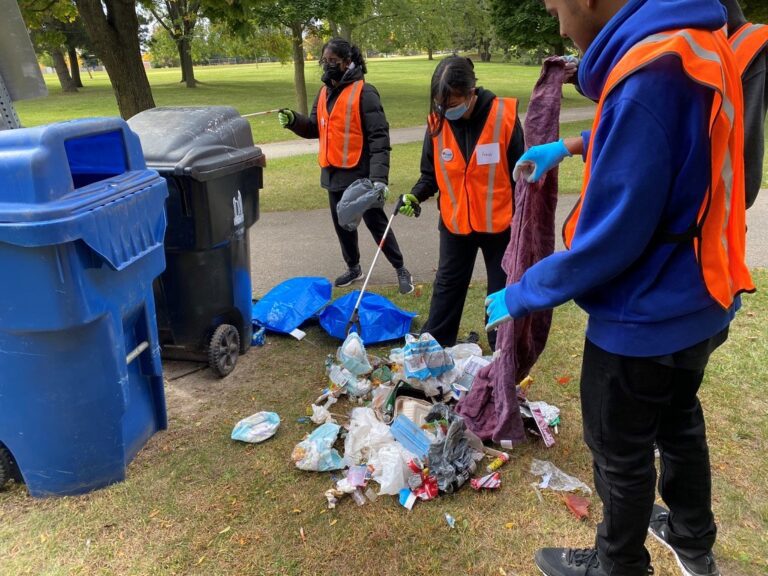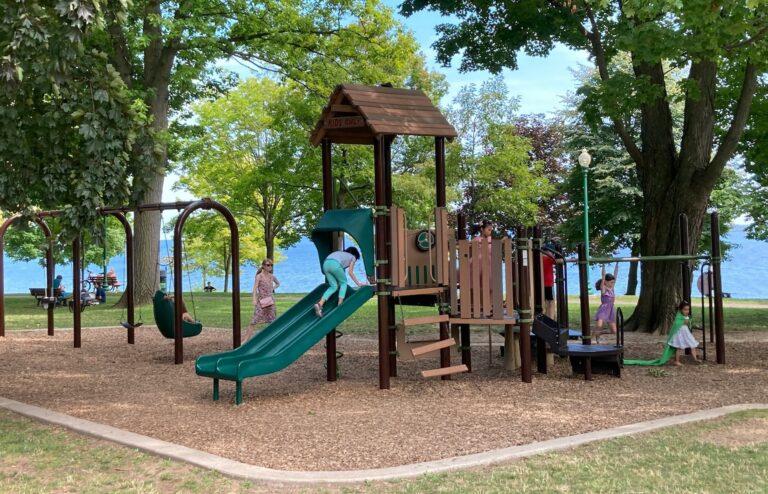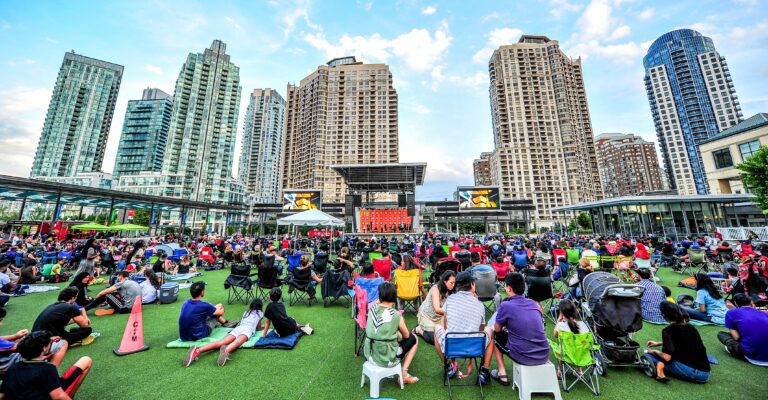The City of Burlington collaborated with Indigenous and community members to create Bimose Agaming | Walking along the Lake, an art walk featuring the work of First Nations, Métis and Inuit artists. Photos: Burlington Public Art
This article is the fourth in a five-part series exploring the connections between placemaking and community wellbeing, written by Canada’s Placemaking Community and Happy Cities. Building on the Power of Placemaking project and our Community Conversations, this article shares learnings about how placemaking initiatives can foster climate resilience at a community level.
This is what we heard through conversations with practitioners shaping spaces across Canada.
How Can Placemaking Contribute to Reconciliation?
Reconciliation is about building and maintaining respectful relationships between Indigenous and non-Indigenous people, as highlighted in the 2015 Truth and Reconciliation Commission report. It involves recognizing past and ongoing harms that settler colonialism has enacted on Indigenous Peoples, and taking action to address these harms and rebuild relationships.
In August, we hosted a Community Conversation with placemakers to share experiences on how placemaking can contribute to reconciliation and centre Indigenous voices, cultures, values, and knowledge. Participants, both Indigenous and non-Indigenous, joined from nearly a dozen different communities, sharing learnings, reflections, and questions about how to support reconciliation through placemaking.
We were grateful to be joined at the session by Cory Douglas, a cultural consultant with an architectural and engineering background, a Coast Salish artist (founder of Modern Formline), and a Squamish Nation member. This article shares insights from the conversation, and explores opportunities for placemaking—and placekeeping—to contribute to ongoing reconciliation in our communities.
Squamish / Haida artist Cory Douglas, standing beside a piece created in collaboration with Maori artist George Nuku. Photo: Cory Douglas
Placemaking shapes how we experience and interact in shared spaces. It includes both physical design changes and the process of inviting community members to shape a shared space—such as through a collaborative public space design process, a community mural or garden, or a community-organized festival or activity.
Places that reflect local cultures and communities strengthen a sense of belonging and foster connections between diverse people. However, many Indigenous people don’t see themselves or their cultures reflected in the design of the environment or the activities that take place there.
Planning practices have long excluded Indigenous cultures and histories, from the use of colonial place names to the forced removal of Indigenous peoples from their lands and traditional territories to build the cities that exist across Canada today.
“Just walking through the city [Vancouver], for example, I don’t see anything that is culturally relevant to Musqueam, Squamish or Tsleil-Waututh in the urban fabric of this city,” said Douglas. “So I always say I feel like I’m a stranger in my own territory.”
Bimose Agaming | Walking along the Lake, an art walk featuring the work of First Nations, Métis and Inuit artists. Photos: Burlington Public Art
Making space for Indigenous cultural contributions
Terms like “placemaking” and “placekeeping” are relatively new words for describing community-led initiatives to improve and steward these places for the benefit of diverse community members.
In his work, Douglas and collaborator Ginger Gosnell-Myers are exploring how “cultural contributions” can strengthen Indigenous representation and “history of place,” by centering Indigenous stories, experiences, and knowledge in the design of public spaces, buildings, and neighbourhoods. Cultural contributions may include placemaking initiatives like local Indigenous-created public art, groundbreaking ceremonies led by Indigenous community members, re-greening spaces with indigenous plants, and more.
Importantly, planning and placemaking projects can support reconciliation by engaging Indigenous community members from the start, and considering reconciliation equally to other professional requirements.
“Every discipline on a project is responsible for adhering to some very strategic design elements,” said Douglas. “So I always use that as a space to challenge my design team members, whether it be architects, whether it be landscape architects, whether it be engineers […] how can they all contribute to this new value system? It’s a committed effort to truth and reconciliation.”
Participants in the session shared examples of ways that placemaking can support this ongoing effort towards truth and reconciliation. Mike Driedger, Program Director at Evergreen—a national non-profit based in Toronto on Treaty 13 territory—shared how the organization has incorporated Indigenous-led programming at its Brick Works site to share traditional knowledge and foster cross-cultural connections.
“Evergreen Brick Works has gone through lots of eco-restoration to make it into a public space that’s welcoming for everybody across the city,” said Driedger. “[It] has programming, trails, markets to try and bring people in and have ongoing, regular activations that make it as welcoming a space as possible for everybody. Part of that is making sure that there are links to Indigenous history and Indigenous programming and staff and placemaking that is happening here.”
The Heart Berry Lodge at Evergreen Brick Works hosts ceremonies and sacred fires. To the left is the Gitigaan garden, where Evergreen staff work with the community to grow native plants and vegetables, following traditional Indigenous food sovereignty and stewardship practices. Photo: EvergreeN.
For example, through Evergreen’s visiting school program, students come to the site to learn about the local ecosystem and connect with nature. Indigenous staff lead educational activities that connect students with traditional knowledge and teachings. The site also has dedicated spaces for Indigenous-run gardens, a heart lodge, and places for ceremony.
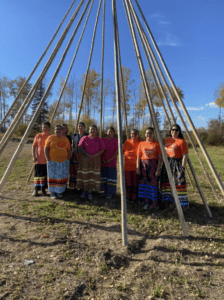
In other examples from our Power of Placemaking research, we heard from Indigenous-led initiatives that have created unique placemaking projects to support a range of community needs, including spaces for healing, social connection, and learning.
In northern Alberta, the High Level Native Friendship Centre used HCI funding to build a new cultural park with a teepee as a central gathering space. The teepee and park were envisioned as a space for Indigenous community members to collectively grieve and honour residential school survivors, following the Tk’emlúps te Secwépemc First Nation 2021 announcement of finding the remains of over 200 children at a residential school site in Kamloops.
Photo: High Level Native Friendship Centre, Alberta.
In another example, the Tuktoyaktuk Community Corporation runs a maker space in the small Arctic community of just 1,000 people. The space offers Indigenous community members workshops, tools, and equipment to produce traditional arts and crafts while developing skills and business opportunities.
Tuktoyaktuk maker space. Photo: Meaghan Brackenbury / Cabin Radio
Engaging meaningfully with Indigenous communities
Participants all recognized that it takes ongoing learning and intentional effort to build relationships with Indigenous communities and support reconciliation through placemaking. Some of the key reflections and actions we heard during the community conversation included:
- Centre Indigenous voices from the start: Create space for Indigenous voices and invite host nation knowledge keepers to participate in and guide the direction of a project at early planning stages. In one example Douglas shared, projects can include a line item in a budget to hire Indigenous consultants and conduct engagement with Indigenous community members, ensuring that this work is a priority rather than an afterthought, and is embedded throughout an entire project.
- Create spaces for pause: Pause and reflect continually throughout a project to engage with Indigenous community members and consider how the work can best support reconciliation.
- Assess impact: Create space after a project has been completed to evaluate: How is the space or initiative supporting inclusion and reconciliation? What could be improved?
- Provide fair compensation: Pay cultural experts for their time and contributions, and ensure that compensation reflects the value and expertise they bring.
- Engage in collaboration and partnerships: For example, within public art, there are many opportunities for collaborations, such as between urban Indigenous artists and non-Indigenous artists, or between Indigenous artists from different nations or communities.
- Invest time and energy into building relationships: It takes time to build trusting relationships, particularly given that relationships between settlers and Indigenous communities have not been built on mutual respect in the past.
Beyond individual placemaking initiatives, cities are starting to implement policy to support the Truth and Reconciliation Commission’s calls to action and the UN Declaration on the Rights of Indigenous Peoples (UNDRIP). For example, in 2024, the City of Vancouver adopted a five-year UNDRIP Action Plan, identifying the public realm as one of several key areas for strengthening Indigenous cultural representation. Focused specifically on placemaking, the Calgary Public Library has an Indigenous Placemaking program that “develops traditional and contemporary artworks that promote understanding of Indigenous peoples and cultures within Treaty 7 territory.”
These policies help set the stage for more possibilities and conversations around prioritizing reconciliation.
“This becomes a very playful ground for us to expand on what we’re calling ‘cultural contributions,’” said Douglas. “How can we contribute to revitalizing Musqueam, Squamish and Tsleil-Waututh traditions [and] cultures in the industry? This becomes a very collaborative opportunity for all of the team members to contribute, and in ways that may be challenging existing policies and procedures [or] industry standard practices. But that’s the beauty of it, being able to come up with more creative solutions [….] That’s really what I want to do on the projects that I’m on, is to inspire people to think a little bit outside of the box [….] This gets me up in the morning. This gets me excited to join the team to be in the room smiling and thinking, ‘What could be done a little bit differently?’”
Learn more about the wellbeing benefits of community-led placemaking initiatives in the Power of Placemaking research report, developed in partnership with Happy Cities. Find and download resources from the report to help you make the case for placemaking in your community!
